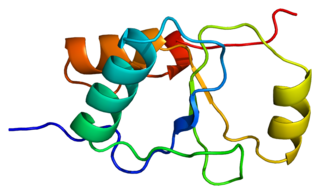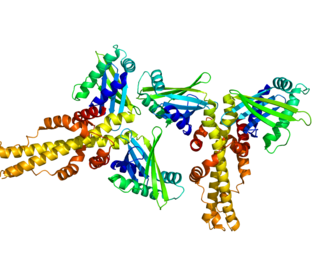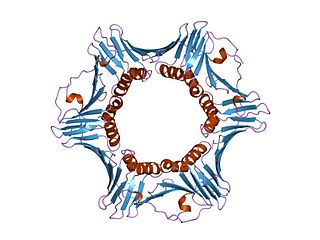Ku70 is a protein that, in humans, is encoded by the XRCC6 gene. [5] [6]
Ku70 is a protein that, in humans, is encoded by the XRCC6 gene. [5] [6]
Together, Ku70 and Ku80 make up the Ku heterodimer, which binds to DNA double-strand break ends and is required for the non-homologous end joining (NHEJ) pathway of DNA repair. It is also required for V(D)J recombination, which utilizes the NHEJ pathway to promote antigen diversity in the mammalian immune system.
In addition to its role in NHEJ, Ku is also required for telomere length maintenance and subtelomeric gene silencing. [7]
Ku was originally identified when patients with systemic lupus erythematosus were found to have high levels of autoantibodies to the protein. [5]
Mouse embryonic stem cells with homozygous Ku70 mutations, that is Ku70−/− cells, have markedly increased sensitivity to ionizing radiation compared to heterozygous Ku70+/− or wild-type Ku70+/+ embryonic stem cells. [8] Mutant mice deficient in Ku70 exhibit early aging. [9] Using several specific criteria of aging, the mutant mice were found to display the same aging signs as control mice, but at a considerably earlier chronological age. These results suggest that reduced ability to repair DNA double-strand breaks causes early aging, and that the wild-type Ku70 gene plays an important role in longevity assurance. [10] (Also see DNA damage theory of aging.)
A mutation in this gene has been described in a set of 24 families with autism. [11] While this is suggestive that this gene may play a role in the development of autism, further investigation is required.
Ku70 has been referred to by several names including:
Ku70 has been shown to interact with:

Proliferating cell nuclear antigen (PCNA) is a DNA clamp that acts as a processivity factor for DNA polymerase δ in eukaryotic cells and is essential for replication. PCNA is a homotrimer and achieves its processivity by encircling the DNA, where it acts as a scaffold to recruit proteins involved in DNA replication, DNA repair, chromatin remodeling and epigenetics.

DNA repair protein XRCC1, also known as X-ray repair cross-complementing protein 1, is a protein that in humans is encoded by the XRCC1 gene. XRCC1 is involved in DNA repair, where it complexes with DNA ligase III.

Ku80 is a protein that, in humans, is encoded by the XRCC5 gene. Together, Ku70 and Ku80 make up the Ku heterodimer, which binds to DNA double-strand break ends and is required for the non-homologous end joining (NHEJ) pathway of DNA repair. It is also required for V(D)J recombination, which utilizes the NHEJ pathway to promote antigen diversity in the mammalian immune system.

Replication protein A 70 kDa DNA-binding subunit is a protein that in humans is encoded by the RPA1 gene.

Interleukin enhancer-binding factor 3 is a protein that in humans is encoded by the ILF3 gene.

DNA damage-binding protein 2 is a protein that in humans is encoded by the DDB2 gene.

DNA ligase 1 is an enzyme that in humans is encoded by the LIG1 gene. DNA ligase I is the only known eukaryotic DNA ligase involved in both DNA replication and repair, making it the most studied of the ligases.

DNA polymerase beta, also known as POLB, is an enzyme present in eukaryotes. In humans, it is encoded by the POLB gene.

Flap endonuclease 1 is an enzyme that in humans is encoded by the FEN1 gene.

Securin is a protein that in humans is encoded by the PTTG1 gene.

Cyclin-O is a protein that in humans is encoded by the CCNO gene.

Myocyte-specific enhancer factor 2D is a protein that in humans is encoded by the MEF2D gene.

Replication factor C subunit 4 is a protein that in humans is encoded by the RFC4 gene.

Replication factor C subunit 3 is a protein that in humans is encoded by the RFC3 gene.

Replication factor C subunit 5 is a protein that in humans is encoded by the RFC5 gene.

DNA repair protein XRCC2 is a protein that in humans is encoded by the XRCC2 gene.

Non-homologous end-joining factor 1 (NHEJ1), also known as Cernunnos or XRCC4-like factor (XLF), is a protein that in humans is encoded by the NHEJ1 gene. XLF was originally discovered as the protein mutated in five patients with growth retardation, microcephaly, and immunodeficiency. The protein is required for the non-homologous end joining (NHEJ) pathway of DNA repair. Patients with XLF mutations also have immunodeficiency due to a defect in V(D)J recombination, which uses NHEJ to generate diversity in the antibody repertoire of the immune system. XLF interacts with DNA ligase IV and XRCC4 and is thought to be involved in the end-bridging or ligation steps of NHEJ. The yeast homolog of XLF is Nej1.

DNA polymerase delta subunit 3 is an enzyme that in humans is encoded by the POLD3 gene. It is a component of the DNA polymerase delta complex.

DNA ligase 3 is an enzyme that, in humans, is encoded by the LIG3 gene. The human LIG3 gene encodes ATP-dependent DNA ligases that seal interruptions in the phosphodiester backbone of duplex DNA.

Replication protein A 32 kDa subunit is a protein that in humans is encoded by the RPA2 gene.